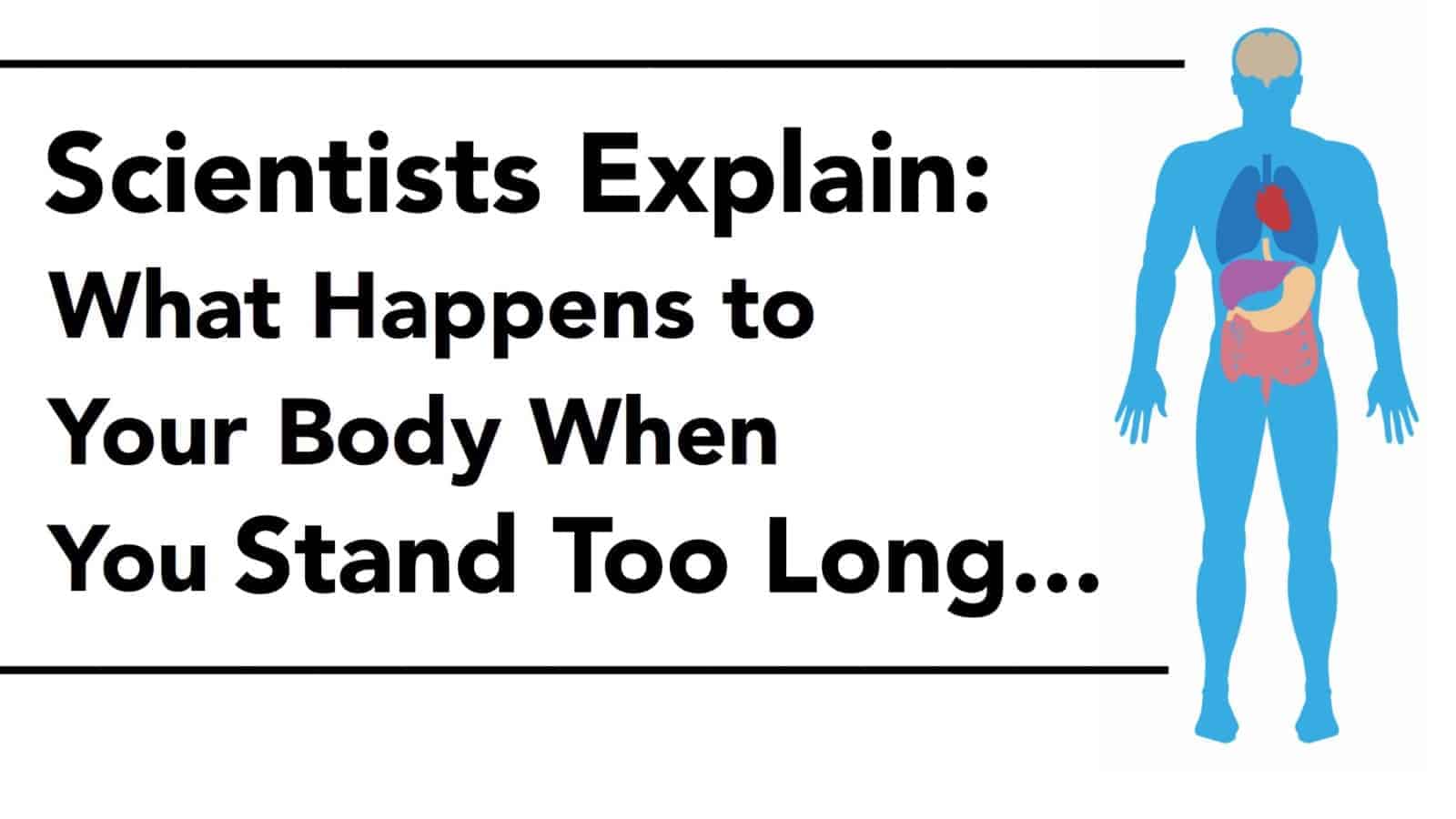What impact does standing too long make on your body?
“Occupations predominantly standing were associated with an approximately 2-fold risk of heart disease compared with occupations involving predominantly sitting.” ~ Smith, P. et al., “The Relationship Between Occupational Standing and Sitting and Incident Heart Disease Over a 12-Year Period in Ontario, Canada”
Sit, stand, do jumping jacks?
Scientists.
They’re a smart breed for sure. (Just ask ‘em!)
They also seem to write contradictory stuff all the time.
First, it’s long periods of sitting that’s harmful to our health. Now, standing is getting a bad rap.
What the heck?
Don’t worry, dear reader. We’ll clear this conundrum up ASAP!
(Jumping jacks while working is probably really healthy. Not sure how the ole’ boss will feel about it, but whatever.)
Let’s Look First at the Issues from Sitting Too Long
As a super-quick refresher, we’re going to talk about the hazards of sitting. Next, we’ll go over what the study says; and, finally, how we can ensure a healthy, happy, (thus, productive) day at work!
Four Scientists Explain What Sitting Too Long Does To Your Body
To be crystal clear, extended periods of sitting is bad. (Mmm-kay?)
Sitting for extended periods, which office workers do, can produce some nasty physical and mental symptoms. Here’s a quick rundown of some:
– Lower back pain
– Neck pain
– Leg pain
– More belly fat (due to inactivity)
– Weaker bones
– Higher risk of depression (the brain/body connection weakens when we’re inactive.)
– Increased risk of diabetes (inactivity hinders insulin function.)
And… here’s some advice on what to do if you’re stuck in a cube:
– Improve your posture: use a keyboard separate from the monitor, don’t slouch, ergonomically position your equipment.
– Take a micro-break every 15 minutes: stand up, change positions, stretch, lean back, deep breathe.
– Reposition your chair and stretch your legs.
– Get some vitamin D and calcium.
– Walk outside when possible: you’ll be surprised at how much a quick open-air breather and a brisk walk will lift your spirits!
– Carry a water bottle with you: try to drink a minimum of 24-36 ounces of water at work. Consuming this amount of water will fight off dehydration, prevent brain fog, and stabilize your blood pressure.
Scientists Explain What Happens to Your Body When You Stand Too Long
The Study
Don’t worry; we’re not going to don a white coat and start lecturing about the study. Instead, we’ll bullet point the important stuff!
– Who?: 7,320 employed Canadians – all working a minimum of 15 hours per week.
– What?: A scientific study, titled “The Relationship Between Occupational Standing and Sitting and Incident Heart Disease Over a 12-Year Period in Ontario, Canada,” which is published in the American Journal of Epidemiology.
– When?: Over a 12 year period. The study began in 2003 and researched followed-up with participants sometime in 2015.
– How?: Patient data points were obtained from the 2003 Canadian Community Health Survey (CCHS), which is linked to one major health insurance provider and a database containing discharge information.
– Why?:
The question “Why?” demands a bit longer of an explanation (sorry!)
First, because cardiovascular disease is the leading cause of morbidity and death in the world. Despite adequate resources, the instances of heart disease in developed countries continues to trend upwards.
The second reason is the vast discrepancy between the amount of research conducted on prolonged sitting versus prolonged standing.
It’s notable that the authors cite eight studies wherein scientists from England, Scotland, and the Netherlands found no relationship between “prolonged occupational sitting, compared with occupations involving standing and walking about, or “occupational sitting time and (heart) disease.”
Regarding the last, the study’s claims about the lack of relationship between prolonged sitting and adverse health outcomes go against those of most doctors and scientists, including the National Health Service of the United Kingdom and the Mayo Clinic.
The Findings
In short, the researchers – after controlling for possible outliers – found that people who primarily stand at work are 232% more likely to develop heart disease than “predominantly sitting populations.”
Of the four types of body posture or movement measured – sitting, standing; sitting, standing, and walking, and ‘other body positions’ – workers who listed prolonged occupational standing as their primary work behavior reported the worst health outcomes.
The healthiest position for working?
That would go to the sitting, standing, and walking crowd! These 2,479 workers – after scientists adjusted for current health conditions – had a whopping 39% lower chance of developing a heart condition.
This finding makes sense, even from a layman’s perspective. Standing, when combined with a bit of walking, increases blood circulation. Meanwhile, a sedentary workstyle – the result of a disproportionate amount of time either standing or sitting on our duffs – isn’t conducive to the body’s physiology.
“A body at rest tends to stay at rest” is a good axiom to remember.
The study’s conclusion, the authors write, “suggests that primary prevention efforts targeted toward reducing occupational standing should be considered…”
Or, in regular terms, more attention and resources should be redirected toward the health consequences about extended periods of standing – not sitting – at work. It also behooves us to include a mix of all three postures and movements when working.
The lesson from all of this? It may be a better idea to incorporate a mix of sitting, standing, and walking throughout our workday. Heading outside during your breaks and lunches sounds pretty good!












 Community
Community

